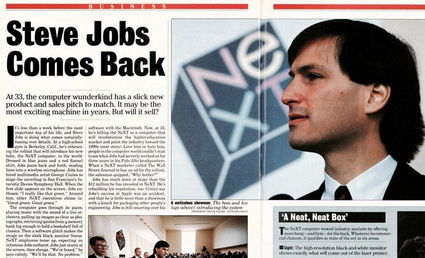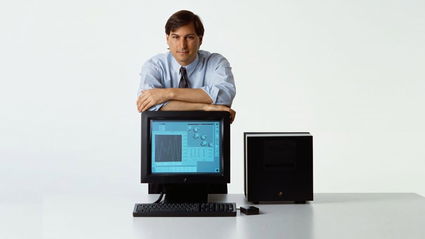NeXT has been very important in technological history, and not just for saving Apple with its innovative operating system
Few people know The Apple we know today is what it is because of NeXTa company founded by Steve Jobs when he was fired from Apple and absorbed when the co-founder returned to the company. NeXT barely sold computers, but its importance in history was greater than its numbers.
This is why we are going analyze NeXT in deptheverything Steve Jobs achieved with this second company and why it was so important, not only for Apple, but also for the rest of the world. Even though he was only active for a decade.
The beginning of the history of NeXT, Steve Jobs’ second company
In 1983, Steve Jobs made the decision to hire John Sculley, then CEO of PepsiCo, to lead Apple with this well-known phrase: “Do you want to continue selling sugar water for the rest of your life or do you want to come with me and change the world?”. At that time, Jobs had no idea what would happen two years later.
Sales expectations for the Macintosh were not met, and Sculley pushed Jobs away from the project, straining their relationship to such an extent that, on September 12, 1985, Sculley convinced the board of directors to Steve Jobs was fired. Although we don’t really know if he was fired as such or if he left before them.
But Steve Jobs was barely 30 years old, so He decided to found what would be his second IT company: NeXT.. Jobs’ goal with NeXT was to develop cutting-edge computers suitable for higher education, an industry Jobs considered underserved at the time.

At just 30 years old, Steve Jobs founded his second technology company
Jobs recruited at this time trusted people within Applewhich led the Apple company to sue Jobs for alleged misappropriation of proprietary information and breach of fiduciary duties. Apple and Jobs reached an agreement: Jobs agreed not to hire any more Apple employees for six months, while NeXT agreed to focus on high-performance computers, avoiding direct competition with Apple computers.
The cube
In 1988, just three years after its creation, NeXT presented its first computer, nicknamed “the cube”. Steve Jobs took it upon himself to present it to a crowd of around 3,000 attendees, revealing the impressive technology it contained.
“The cube” used a Motorola 68030 25 MHz processorcomplemented by a Motorola 56001 digital signal processor, it also featured an innovative integrated 256MB magneto-optical drive, setting a new standard in data storage. But most impressive was its software, NeXTSTEP, a robust UNIX-based system with an intuitive, proprietary graphical user interface.

It was the first NeXT computer
Sales are not keeping up
Although it had many innovations and was one of the most powerful computers of the time, NeXT did not achieve expected sales. About 1,000 Macs were sold for each NeXT, leading the company, in 1990, to release the NeXTstation and NeXTstation Color, with an upgraded 68040 processor and a 32-bit true color display.
However, sales remained insufficient, so in 1993 NeXT made an important decision: completely stopped hardware production and focused on software development. NeXTSTEP, its operating system, has been quite well received for its advanced object-oriented programming environment, especially in the business and financial sectors.
The takeover by Apple
In 1996, Apple was in a difficult economic situationlargely due to problems with its operating system. Due to this situation, Apple understood that it was a good option to acquire another company that would solve this problem, since attempts at internal development did not seem to work.
Apple’s CEO at the time was Gil Amelio, who had a different perspective than other CEOs by being an engineer. After ruling out other options, including using Microsoft’s Windows NT, Apple’s board realized that The best option was to reach an agreement with NeXT to use your operating system.
The only problem was that Gil Amelio had already argued with Steve Jobsso he didn’t dare start this difficult conversation. But the company’s situation forced him to do so.
Finally, in 1996, Apple acquired NeXT for $429 million, plus 1.5 million Apple shares for Steve Jobs. The original goal was to use NeXTSTEP as its operating system, but this purchase also marked the return of Steve Jobs as a consultant.

Within months, Jobs took control of Apple
It took Steve Jobs less than seven months to be named interim CEO of Apple. An appointment he held until 2000, when Steve Jobs definitively took over the management of the group. Jobs completely restructured the company, eliminating product lines to focus on a handful of devices in order to grow and transform Apple into the company we know today.
NeXT’s major achievements
Many developers have used the NeXT platform to write pioneering programs. Among them, it is worth highlighting Tim Berners-Lee, who used a NeXT Computer in 1991 to create the first web browser and server. The World Wide Web is an achievement etched in NeXT history.
But this is not the only achievement made on a corporate computer. In 1990, John Carmack used a NeXT cube to build two of his first games: Wolfenstein 3D and Doom. In the short time it has been on the market, NeXT has played a pivotal role in the technology world.
You can follow iPadized on Facebook, WhatsApp, Twitter (X) or check out our Telegram channel to stay up to date with the latest tech news.
Table of Contents



